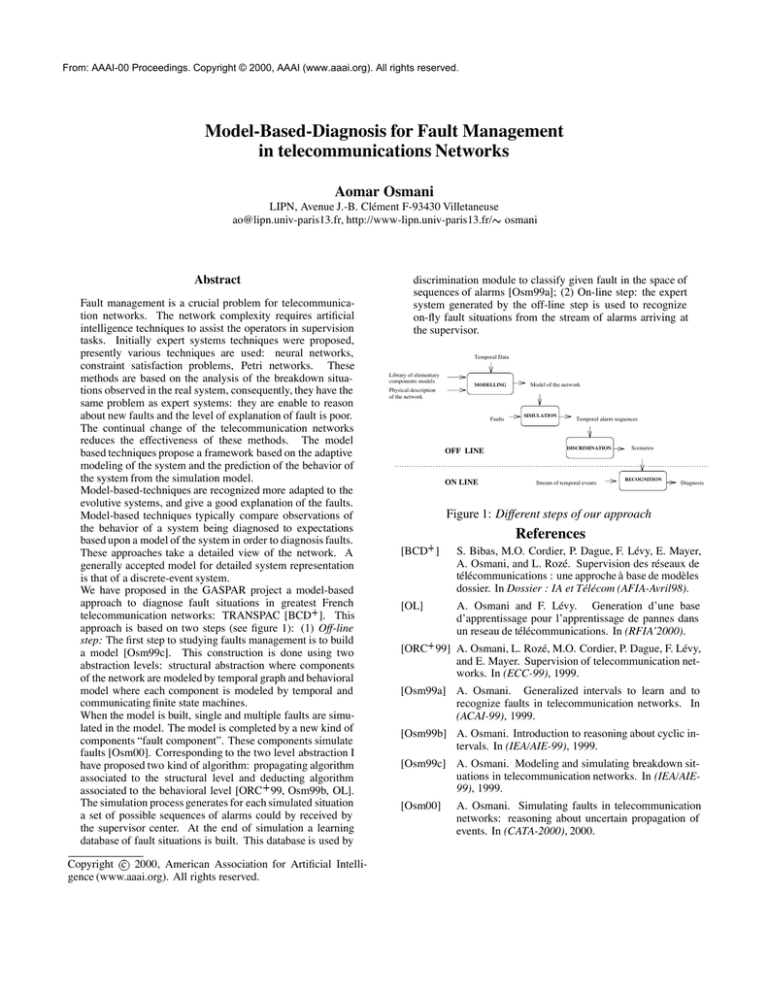
From: AAAI-00 Proceedings. Copyright © 2000, AAAI (www.aaai.org). All rights reserved.
Model-Based-Diagnosis for Fault Management
in telecommunications Networks
Aomar Osmani
LIPN, Avenue J.-B. Cl€ement F-93430 Villetaneuse
ao@lipn.univ-paris13.fr, http://www-lipn.univ-paris13.fr/ osmani
Abstract
Fault management is a crucial problem for telecommunication networks. The network complexity requires arti•cial
intelligence techniques to assist the operators in supervision
tasks. Initially expert systems techniques were proposed,
presently various techniques are used: neural networks,
constraint satisfaction problems, Petri networks. These
methods are based on the analysis of the breakdown situations observed in the real system, consequently, they have the
same problem as expert systems: they are enable to reason
about new faults and the level of explanation of fault is poor.
The continual change of the telecommunication networks
reduces the effectiveness of these methods. The model
based techniques propose a framework based on the adaptive
modeling of the system and the prediction of the behavior of
the system from the simulation model.
Model-based-techniques are recognized more adapted to the
evolutive systems, and give a good explanation of the faults.
Model-based techniques typically compare observations of
the behavior of a system being diagnosed to expectations
based upon a model of the system in order to diagnosis faults.
These approaches take a detailed view of the network. A
generally accepted model for detailed system representation
is that of a discrete-event system.
We have proposed in the GASPAR project a model-based
approach to diagnose fault situations in greatest French
telecommunication networks: TRANSPAC [BCD ]. This
approach is based on two steps (see •gure 1): (1) Off-line
step: The •rst step to studying faults management is to build
a model [Osm99c]. This construction is done using two
abstraction levels: structural abstraction where components
of the network are modeled by temporal graph and behavioral
model where each component is modeled by temporal and
communicating •nite state machines.
When the model is built, single and multiple faults are simulated in the model. The model is completed by a new kind of
components ‚fault componentƒ. These components simulate
faults [Osm00]. Corresponding to the two level abstraction I
have proposed two kind of algorithm: propagating algorithm
associated to the structural level and deducting algorithm
associated to the behavioral level [ORC 99, Osm99b, OL].
The simulation process generates for each simulated situation
a set of possible sequences of alarms could by received by
the supervisor center. At the end of simulation a learning
database of fault situations is built. This database is used by
Copyright c 2000, American Association for Arti•cial Intelligence (www.aaai.org). All rights reserved.
discrimination module to classify given fault in the space of
sequences of alarms [Osm99a]; (2) On-line step: the expert
system generated by the off-line step is used to recognize
on-„y fault situations from the stream of alarms arriving at
the supervisor.
Temporal Data
Library of elementary
components models
MODELLING
Model of the network
Physical description
of the network
Faults
OFF LINE
ON LINE
SIMULATION
Temporal alarm sequences
DISCRIMINATION
Stream of temporal events
Scenarios
RECOGNITION
Diagnosis
Figure 1: Different steps of our approach
References
[BCD ]
S. Bibas, M.O. Cordier, P. Dague, F. L€evy, E. Mayer,
A. Osmani, and L. Roz€e. Supervision des r€eseaux de
t€el€ecommunications : une approche à base de modèles
dossier. In Dossier : IA et T€el€ecom (AFIA-Avril98).
[OL]
A. Osmani and F. L€evy. Generation d…une base
d…apprentissage pour l…apprentissage de pannes dans
un reseau de t€el€ecommunications. In (RFIA…2000).
[ORC 99] A. Osmani, L. Roz€e, M.O. Cordier, P. Dague, F. L€evy,
and E. Mayer. Supervision of telecommunication networks. In (ECC-99), 1999.
[Osm99a] A. Osmani. Generalized intervals to learn and to
recognize faults in telecommunication networks. In
(ACAI-99), 1999.
[Osm99b] A. Osmani. Introduction to reasoning about cyclic intervals. In (IEA/AIE-99), 1999.
[Osm99c] A. Osmani. Modeling and simulating breakdown situations in telecommunication networks. In (IEA/AIE99), 1999.
[Osm00]
A. Osmani. Simulating faults in telecommunication
networks: reasoning about uncertain propagation of
events. In (CATA-2000), 2000.






